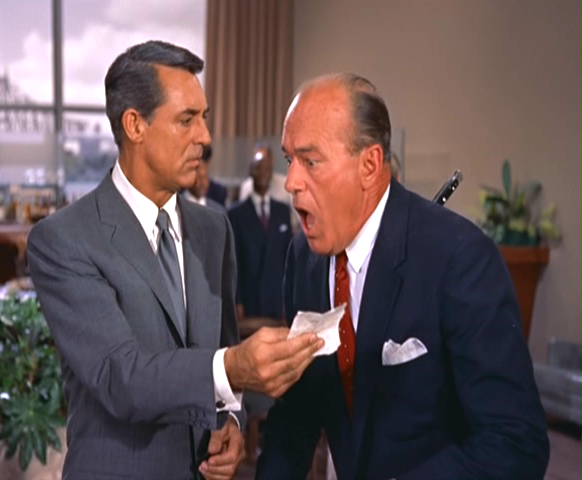In France, North by Northwest is known as La mort aux trousses, which might translate as “Death is After Him” or “Death on his Heels.” The French title is insightful as it underscores the manner in which castration threats are played out in the film’s oedipal narrative. Quite simply, the threat of castration is tantamount to the threat of death.
As already mentioned, North by Northwest’s narrative conceives two father figures: Vandamm and the Professor. Each contends with Thornhill for possession of Eve; each subscribes to his own brand of morality; each forces his morality on Thornhill and threatens him with castration (Vandamm actively does so while the Professor does so passively) if he refuses to espouse it.
Freud’s oedipal complex is the result of culturalization, and the rules that are borne thereof. Thus, Freud’s patriarchal rules are not universal, but culturally defined. The dialectic of the opposing moralities of the father figures is epitomized by the film’s MacGuffin, which Hitchcock considered to be the best of all of his films as it really did represent nothing [6]. In “the pumpkin” are state secrets that Vandamm is attempting to bring to the Soviets. Thus, Vandamm’s and the Professor’s opposing moralities are very much a part of the Red Scare culture that existed in the United States during the 1950s. Rightfully so—as they are very much a part of the MacGuffin—the film’s definition of the conflicting paternal moralities is as vague as Freud’s. Which acts are taboo? Those which our culture declares to be taboo. Why are communists evil? Because they threaten to supplant the economic systems at the base of our culture. These types of questions and answers epitomize the internalization process through which the superego develops. The acceptable and the taboo are learned through experience. Indeed, the same is true of castration anxiety.
Significantly, Thornhill’s meetings with each father end in attempts to castrate him. Upon meeting Vandamm, Thornhill, who is assumed to be a government spy hot on Vandamm’s trail, is presented with the opportunity to commit treason and spill state secrets. As he has none to offer, Vandamm subjects him to a figurative—or perhaps not so figurative—rape via forced drunkenness and attempts to kill him by sending him over the edge of a cliff in "Laura’s Mercedes." Upon meeting the Professor, Thornhill becomes complicit in a plan to save Eve from suspicion. Raymond Bellour notes that, in faking his death, Thornhill has accepted his castration [7]. This acceptance seems to be Thornhill’s acquiescence to the Professor’s morality in exchange for possession of Eve, the figurative mother. However, Thornhill is deceived by the Professor and it is not until Roger defies him once more, and the Professor’s possession of Eve becomes untenable, that the Professor permits Roger to possess her by saving both Eve and Thornhill from Leonard at the film’s climax.
Musically, the notion of la mort aux trousses is perhaps best realized in Herrmann’s overture to the film. Herrmann employs a fandango, which Israel Katz describes as “a couple-dance in triple metre and lively tempo…considered the most widespread of Spain's traditional dances. Its metre, associated with that of the bolero and seguidilla, was originally notated in 6/8, but later in 3/8 or 3/4” [sic] [8]. Written in 3/8 notation, Herrmann’s fandango contains hemiolae which Julian Rushton describes as articulations of “two units of triple metre as if they were notated as three units of duple metre” [sic] [9]. In this sense, Herrmann creates the appearance of a meter that shifts between 3/4 and 6/8 without actually altering the notation.

